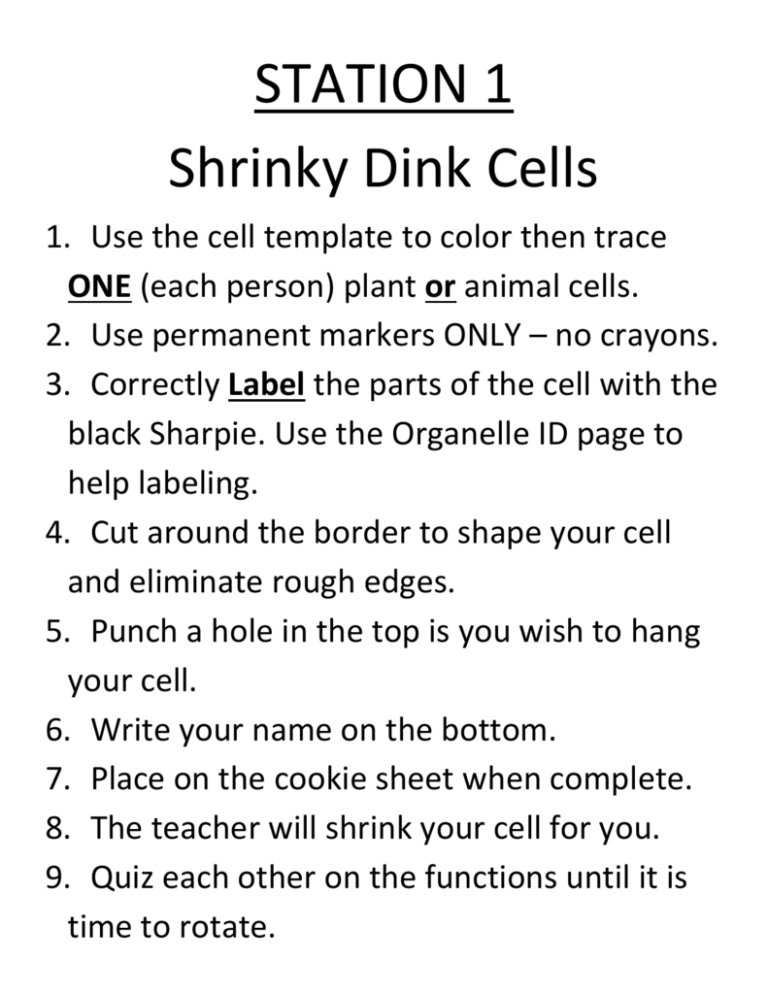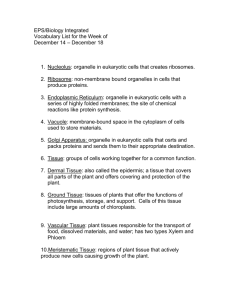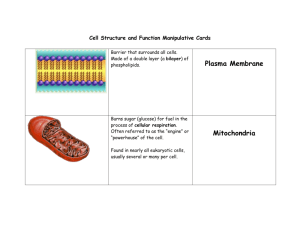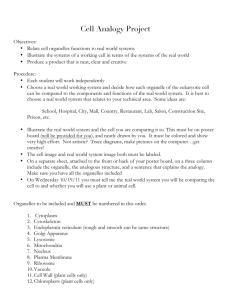STATION 1 Shrinky Dink Cells 1. Use the cell template to color then
advertisement

STATION 1 Shrinky Dink Cells 1. Use the cell template to color then trace ONE (each person) plant or animal cells. 2. Use permanent markers ONLY – no crayons. 3. Correctly Label the parts of the cell with the black Sharpie. Use the Organelle ID page to help labeling. 4. Cut around the border to shape your cell and eliminate rough edges. 5. Punch a hole in the top is you wish to hang your cell. 6. Write your name on the bottom. 7. Place on the cookie sheet when complete. 8. The teacher will shrink your cell for you. 9. Quiz each other on the functions until it is time to rotate. STATION 2 POP-UP CELLS 1. Choose ONE – plant or animal cell (opposite of your shrinky dink cell) to make a pop-up cell. 2. Color the organelles with colored pencil PRIOR to cutting. 3. Follow the direction on the paper labeled PROCEDURE – Be sure to FOLLOW DIRECTIONS in order. OMIT PART 3 4. Complete the blanks with the correct functions for each organelle you have on your pop-up cell. 5. CLEAN-UP – Throw away all scrap paper and replace all colored pencils into the tub when finished. 6. If you finish with time remaining – QUIZ your station partners on the functions of the organelles and compare the differences between the plant and animal cells. STATION 3 CELL QUIZLET 1. 2. Log onto the computer using YOUR LOGIN Access the QUIZLET website http://quizlet.com/_cv12l 3. Play the games SCATTER and SPACE RACE 4. Explore the LEARN activity 5. Take the TEST 6. Record your grade and highlight any organelle functions you missed in your journal on the “cell structures and functions” worksheet. 7. CREATE FLASH CARDS using the index cards provided for each organelle – write the cell structure on one side and the function on the other. STATION 4 CELL ANALOGY BOOK 1. Using the cell structures and their functions create a comparative analogy T-chart like the one below. You MUST create at least 10 analogies using different organelles. Organelle in Cell Part of Analogy FUNCTION Facility Nucleus Mayor Controls all cell functions / controls all city activities Vacuole Water Tower Stores water, and treatment nutrients and plants waste 2. Once you have completed your brainstorming chart - Create a BOOK to record your analogies in a creative, colorful, illustrated product. 1 analogy per page! See examples. 3. Use the computer paper as your pages and a sheet of construction paper as a cover. 4. Colored pencils are available to illustrate. 5. IDEAS: Mall, School, Sports Stadium, Military, USA, Boat, Concert, Fire Station, Play, Amusement Park, Disney World, Airport or one of your own. STATION 5 Cell Comparison 1. In your journal draw a typical animal cell and a typical plant cell INDICATE the DIFFERENCES with noticeable markings such as * 2. Refer to the chart below to note the differences between Prokaryotic and Eukaryotic Cells – Draw a typical Prokaryotic cell and a typical Eukaryotic Cell – INDICATE the DIFFERENCES with a * Eukaryotic Cell Nucleus: Present Absent Number of chromosomes: More than one One--but not true chromosome: Plasmids Cell Type: Usually multicellular Usually unicellular (some cyanobacteria may be multicellular) True Membrane bound Nucleus: Present Absent Example: Animals and Plants Bacteria and Archaea Genetic Recombination: Meiosis and fusion of gametes Partial, cell division - transfers DNA Lysosomes and peroxisomes: Present Absent Eukaryotic Cell Microtubules: Present Absent or rare Endoplasmic reticulum: Present Absent Mitochondria: Present Absent Cytoskeleton: Present May be absent Ribosomes: larger smaller Vesicles: Present Present Golgi apparatus: Present Absent Chloroplasts: Present (in plants) Absent; chlorophyll scattered in the cytoplasm Flagella: Microscopic in size; membrane bound; usually arranged as nine doublets surrounding two singlets Submicroscopic in size, composed of only one fiber Cell wall: Only in plant cells and fungi (chemically simpler) Usually chemically complexed Vacuoles: Present Present Cell size: 10-100um 1-10um 3. Complete the Venn Diagram to summarize the similarities of plant vs animal and eukaryote vs prokaryote STATION 6 CELL STRUCTURE SORT 1. Each student should empty their own Ziploc bag of cell parts, words and functions onto the table. 2. Spread out the cell structures – matching the correct word to the visual picture of the structure to the correct function. 3. Check your results with those of your station partners. 4. Shuffle and Return the cards to the correct Ziploc bag without mixing them with another person’s bag. 5. Quiz each other of the parts of the cell and their functions if you have time remaining.








